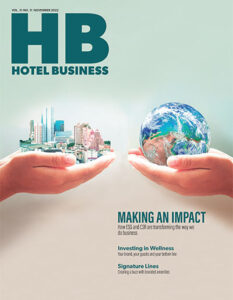The environment is more important now than ever to hotel guests. MindClick, a product intelligence company, rates the environmental health performance of products, making it simple for hoteliers to live to up guests’ expectations and create healthy hospitality interiors. At the helm of MindClick is CEO JoAnna Abrams, who spoke with Hotel Business about her commitment to the environment, the company’s ESG efforts and even gave some insight into the future. —Abby Elyssa
Where did your passion for both hospitality and the environment come from?
I grew up in a small lumber town in Oregon and witnessed firsthand the challenges between the role of the forest and natural resources as pillars of the economy, recreational playgrounds and our common home. We traveled often to “see the bigger world,” and the highlight of traveling for me was the beautiful hotels and the fun of discovering different cultures, food and fashion.
Can you detail what MindClick does in the hospitality space?
MindClick is the hospitality industry’s data and analytics solution for environmentally and socially responsible design and purchasing. Through cloud-based data and analytics, decision tools and impact reporting, we help brands, owners and operators ensure the products they specify and purchase advance their ESG goals—net zero carbon emissions, healthy interiors, waste reduction, circularity and DEI.
We make this possible by providing product ratings—comprised of a comprehensive evaluation of environmental (sustainability) and social responsibility (DEI, fair labor and human rights) performance based on globally accepted standards. We call this the MindClick Sustainability Assessment Program (MSAP).
While many manufacturers have invested in sustainable and healthy material sourcing, carbon reduction, operating efficiencies and circularity (product reuse/take-back programs), it’s been difficult for their customers—designers and buyers—to wade through all the eco-labels and certifications to understand their story, and to answer the question of which products best support their ESG goals. MSAP and the resulting ratings, as well as supporting data and analytics, solve that problem and provide an efficient and comprehensive way for designers, specifiers and purchasers to understand the impact of any and all products they’re considering.
We created our solution in response to Arne Sorensen’s vision. He believed, as a global leader, Marriott has a responsibility to lead the way and challenged the team to implement programs to “green the global supply chain.”
Our ratings (updated annually) and the associated data and analytics support ESG reporting requirements and property marketing and promotion to help hotels respond to corporate travel buyers and consumer demand for more sustainable travel.
Why is a company like MindClick so vital in the industry?
One of the biggest challenges our industry faces is that of climate change. It’s impacting where, how and when people travel. It’s disrupting supply chains, contributing to labor shortages and impacting access to capital. The building industry is responsible for more than 40% of global carbon emissions. Add to that the impact of interiors. Multiple interior renovation cycles in a building are equivalent to the building envelope itself.
The good news is that this is a challenge we can tackle with data. We make tens of thousands of choices every day. Imagine if you had information that quickly and easily helped you make a choice that was better for the planet without compromising quality, lead times, price, design aesthetic, etc. Wouldn’t you make the better choice? That’s what we’re making possible. Can we use recycled and sustainably harvested materials in our products? Yes. Can products use less packaging? Yes. Can products be recycled, reused and taken back? Yes. Can we buy products made closer to the hotels they’re purchased for? Yes. Can we use renewable energy to power manufacturing? Yes. Can distribution be powered using EV? Yes.
If this becomes a standard expectation in design guidelines, specifications and purchasing, and encourages innovation throughout our supply chains, the exponential impact will reduce our global carbon emissions and the impact on climate.
What are you excited about? What are you currently working on?
We have more than 30 projects—new-construction and renovations—in the U.S. and now in Europe in which our data and analytics are being used to guide design and purchasing choices to support ESG goals. Those projects are a mix, from select-service to lifestyle to luxury, across well-known brands and independents.
We’re seeing changes in design choices, specification details and purchasing decisions in which the impact story of products has an equal seat at the table with price, quality, lead times, location and other decision criteria. We’re seeing incredible innovation in take-back programs, light weighting of packaging, design in place, use of innovative materials and more. I’m most excited about the enthusiasm and support we’re seeing everywhere. I think people genuinely want to make a positive impact but haven’t known how or haven’t had the tools, data and analytics to help them. It’s exciting to see so many now coming together in support of solving a shared problem with energy, enthusiasm and hope.
What trends are you expecting in the next few years?
To name a few: changes in design practices, rapid expansion of technology solutions, changes in product design, changes in contract terms and purchasing criteria, changes in asset valuations to include ESG performance and increased regulatory requirements to support decarbonization.
What challenges is the industry currently facing when it comes to ESG? How are you working to overcome those?
Challenge 1 is the misinformation and confusion over ESG. We’re working hard to guide and educate—through speaking engagements, webinars, one-on-one conversations and training programs Challenge 2 is the belief that it isn’t possible to get data from the supply chain. We’re showing that it is not only possible, but vendors are eager to be at the table when the following occurs: 1) Collaboration, recognition and engagement aligning the efforts of manufacturers and the needs of their customers; 2) Demonstrated use of the data manufacturers are providing in design and purchasing decisions—and proof that the investments they’re making to support ESG are paying off; and 3) More opportunities for dialogue with their customers to help advance innovative solutions in meeting ESG goals.
What’s the best advice you’ve ever received, and what’s a piece of advice you have for young professionals?
Wow… I’ve had great advice from so many who have gone before me. A couple that stand out are don’t let the perfect be the enemy of the good, and always ask the question.
Advice to young professionals: Be open to the interesting and even unconventional opportunities that come your way. It’s where you can get the greatest hands-on/growth opportunities.


